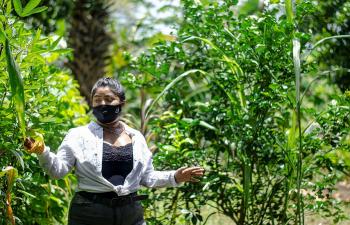Because of all of its advantages, agroforestry is quite promising, especially in a nation like Mexico. Integrating trees and shrubs into agricultural systems is a method that is prioritized for sustainable land use since it offers a variety of possibilities. There are reasons whyvolunteers in Mexico sign up for Agroforestry programs.
An example of sustainable land management in Mexico's agricultural environment is the incorporation of agroforestry practices. Intentionally planting trees alongside crops has the potential to support agricultural productivity while also establishing a robust ecosystem that tackles urgent environmental and socio-economic issues. This study explores the benefits and extent of agroforestry practices in Mexico, highlighting the reasons that agroforestry should be given top priority in the nation's efforts to achieve sustainable development.

1.Conservation of Biodiversity:
Agroforestry fosters biodiversity by establishing a variety of ecosystems. It creates a more resilient environment, improves soil health, and offers habitat for a variety of animals. Natural habitats and endemic species can be preserved with the aid of agroforestry in Mexico, a country with great biodiversity that confronts threats.
2.Soil Conservation and Fertility:
In agroforestry systems, trees and shrubs help to maintain soil fertility by preventing soil erosion. Because of the way their root systems hold the soil, there is less chance of erosion from wind or water. Furthermore, the organic matter and leaf litter they supply enhance the soil and increase its production.
3.Mitigation of Climate Change:
Mexico is confronted with climate-related issues, and agroforestry can be a key component of this effort. Trees reduce the impact of greenhouse gases by removing carbon dioxide from the atmosphere. Mexico can offset emissions and help sequester carbon by introducing trees into agricultural settings.
4.Economic Benefits:
Agroforestry gives farmers access to a variety of revenue streams. It provides goods like fruits, nuts, lumber, and medicinal plants, all of which support stable economies. Agroforestry gives farmers in Mexico, where agriculture plays a big role in the economy, a way to make money while encouraging environmentally friendly practices.
5.Water Management:
In agroforestry systems, trees may control water cycles, which enhances soil water retention and lowers the likelihood of floods or droughts. In Mexico, where water scarcity is a major problem in many areas, this element is vital.
Setting agroforestry methods as a top priority in Mexico delivers real benefits and is consistent with larger aims of sustainable development:
- Sustainability: By combining ecological, economic, and social benefits, agroforestry encourages long-term sustainability.
- Resilience: Agroforestry produces diverse landscapes that are less vulnerable to diseases, pests, and climate change, which lowers risks for farmers.
- Food Security: Agroforestry helps to provide food security, which is important given Mexico's expanding population, by increasing soil fertility and producing a variety of harvests.
Furthermore, indigenous tribes in Mexico have a long history of using agroforestry techniques, which makes it both culturally meaningful and a chance to combine conventional wisdom with cutting-edge sustainable agriculture methods.
By giving agroforestry top priority, Mexico can simultaneously address several issues and promote a more resilient, sustainable, and productive agricultural environment.
In summary, agroforestry approaches must be embraced and prioritized if Mexico is to achieve sustainable agriculture and environmental preservation. Since the project has a large scope, so involving the volunteers is a genuine step to conduct and familiarize Agroforestry practices. Volunteers in Mexico are always ready to assist in this benevolent cause. The manifold benefits that include biodiversity preservation, improving soil health, mitigating the effects of climate change, diversifying the economy, and managing water resources emphasize how urgent and important it is to adopt agroforestry. Mexico can create a future where agricultural productivity synchronizes with ecological resilience, guaranteeing a thriving environment for future generations, by respecting ancient wisdom and utilizing contemporary science.
